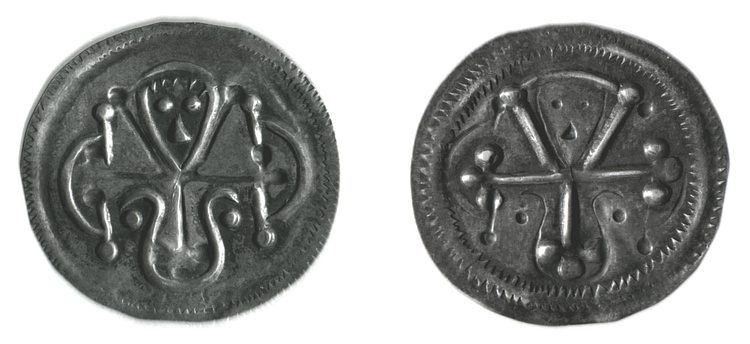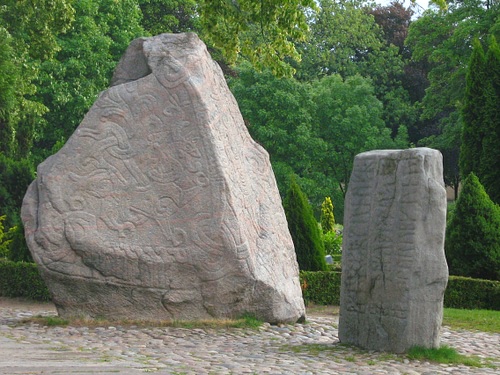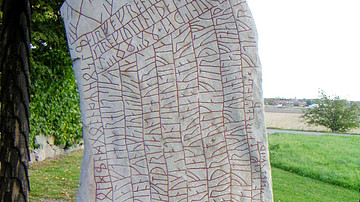In Scandinavia, Christianity spread due to the support and encouragement of political rulers at the top of the society above all else. Conversion, defined here as the actions taken by kings or clerics to introduce the new religion, did not look the same in all countries, which were not even fully established during the Viking Age. The conversion of Denmark and Sweden used less force than in Norway. The Danish Harald Bluetooth (Blåtand) Gormsson (c. 910 - c. 987), the king with the bad tooth whom the standard wireless connection has made famous, was baptised around 960, whereas in Norway Olaf Tryggvasson (c. 960-1000) set in motion a wide-scale conversion around 995, and in Sweden Olof Skötkonung (c. 980-1022) accepted it around 1000.

In order to gain power over the north, Frankish emperors encouraged missionaries, especially from the archbishopric located in present-day Germany. Given their influence on liturgy and medieval church architecture, missionaries from England probably played a part as well. The political relationships between the different kings of Scandinavia also influenced the course of events. According to Rimbert the archbishop of Hamburg-Bremen in the 9th century, king Olof at Birka was sent a message from King Horik of Denmark to allow the monk Ansgar to introduce Christianity. Later on, such involvement seems to have continued, as Cnut, king of both Denmark and England (r. 1016-1035), led campaigns in Götaland when he might have tried to spread Christianity, as his law code dealt a lot with church matters. In other words, Christianization was a result both of external and internal pressure.
In Denmark, Harald Klak (l. c. 785 - c. 852) was the first king in Denmark to be baptised, in order to receive the support of Louis the Pious (r. 813-840), however, his contribution to conversion was minor. On the other hand, Louis organized the missions of Ansgar and Ebo of Reims. Christianity started gaining ground thanks to Harald Bluetooth, whose baptism was also linked to Frankish affairs. Harald was crowned in 958, and his conversion might have occurred around 960 or later. Archaeological data suggests that he removed the remains of his parents and took away the stones of the ship surrounding the mounds, possibly a gesture attesting to the change of faith. He gradually established his new headquarters in Roskilde and contributed to the construction of the defensive fortification called Danevirke. He also expanded a network of fortresses, such as Trelleborg, Aggersborg, Fyrkat, or Borgby.
Harald's Conversion
The Chronicle of Widukind, from around 970, relates how Harald ordered the rejection of the old gods.
In times past, the Danes were Christians, nevertheless continued to worship idols in their traditional manner. But then there was a dispute in the presence of the king during a feast regarding the worshipping of their gods. The Danes affirmed that Christ was a god. But they claimed that there were other, greater gods, who manifested themselves to people through even more powerful signs and prodigies. Against this, a certain cleric named Poppo, who is now a bishop and leads a religious life, proclaimed that there is one true God, the father, along with his only begotten son, Jesus Christ, and the Holy Spirit. The images, he proclaimed, were of demons and not gods. King Harald, who it is said was quick to listen but slow to speak, asked if Poppo wished to demonstrate this faith through his own person. Poppo responded without hesitation that he wished to do so. The king then ordered that the priest be placed under guard until the next day. When morning came, the king ordered that a very heavy piece of iron be heated in the fire. He then ordered the cleric to carry this glowing iron for his Catholic faith. The confessor of Christ seized the iron without any fear at all and carried it far as the king had ordered. The priest then showed everyone his unharmed hand and gave proof to everyone there of his Catholic faith. As a result, the king became a Christian and decreed that God alone was to be worshipped. He ordered all of his subjects to reject idols and gave all due honor to the priests and servants of God. But these events also are to be ascribed to the virtues and merit of your father by whose efforts the churches and orders of priests shined forth in these regions. (Widukind, tr. B. and D. Bachrach, 139-140).
The last sentence refers to Otto I, Holy Roman Emperor (r. 962-973), who had made claims at the synod of Ingelheim to supervise the development of a diocesan organization in Denmark under the jurisdiction of the archbishops of Hamburg-Bremen. Poppo, on the other hand, seems to have been a collaborator of archbishop Bruno of Köln (Cologne). Widukind’s focus on the miraculous event that triggered Harald’s change of heart can be explained through his background, as the author was educated at the Benedictine monastery of Corvey in Saxony, and besides his Res gestae saxonicae (The Deeds of the Saxons), he also wrote hagiographies.
Traces of the story about Harald’s baptism after witnessing Poppo’s miracle can be found much later in some Icelandic sagas, for example in the Saga of Olaf Tryggvasson from the Heimskringla collection belonging to 13th-century poet and historian Snorri Sturlusson. Interestingly, in this saga, Harald is converted by Otto II (r. 973-983) alongside Jarl Haakon of Norway (c. 937-995), with the request to Christianise everyone, yet after a while, he began raiding again and performing sacrifices. This comes to underline the idea that faith was quite a volatile concept at the time and religion rather a formal affiliation.
Despite Widukind’s religious depiction, Harald might just have been politically motivated to convert and prevent the Roman-German emperor from invading Denmark using the crusade as an excuse. The clerical culture that was evolving in the Holy Roman Empire and the sacred exaltation of the emperor might have also made pagan rulers more interested in conversion, as a way toward more authority.
While Widukind was a contemporary of Harald and Otto, the chronicler Adam of Bremen who retells this story lived a hundred years later and has a different view. Adam describes that the emperor battled the Danes and the invasion is explained as a consequence of the murder of Otto’s legates and margrave and the destruction of a colony of Saxons. Otto then devasted the area of Schleswig up to the gulf of Kattegat and was met by Harald. After the defeat of the Danes, we are told that
Harold submitted to Otto and, on getting back his kingdom from the latter, promised to receive Christianity into Denmark, Not long after Harold himself was baptized together with his wife, Gunnhild, and his little son, whom our king raised up from the sacred font and named Svein Otto. At that time Denmark on this side of the sea, which is called Jutland by the inhabitants, was divided into three dioceses and subjected to the bishopric of Hamburg. In the church at Bremen are preserved the eoyal edicts which prove that King Otto held the Danish kingdom in his jurisdiction, so much so that he would even bestow the bishoprics. (Adam of Bremen 1959, 56).
Adam goes on to speak of how Pope Agapetus (r. 946-955) congratulated the church of Hamburg and conceded Adaldag, archbishop between 937 and 988, the right to consecrate bishops as papal legates to Denmark and other areas in the north. Harald allegedly remained a defender of Christianity, but when defeated in a rebellion in favour of his son Sweyn Forkbeard, he was obliged to seek refuge among the Slavs where he died. Adam expresses his sympathy towards Harald, wishing he would receive the crown of martyrdom. According to this account, his body was taken to Roskilde and buried in the church he had built in honour of the Holy Trinity.
Adam of Bremen, the author of Gesta Hammaburgensis ecclesiae pontificum (Deeds of Bishops of the Hamburg Church), might have had a different account of the conversion with the propagandistic purpose to praise the work of the archbishopric. He was willing to exaggerate the role Hamburg played in the conversion, even making it a site of Norse incursion in 845 when it was barely inhabited. At the time of his writing, Hamburg was struggling to maintain its area of influence and so there are serious reasons to doubt his account. According to Adam, Harald is baptised as a result of war, and all these events supposedly occur before 948, when the bishops of Slesvig, Ribe, and Aarhus were appointed at Ingelheim, but the invasion Adam reports never took place (Lund, 305). The battle he is referring to was fought between Harald and Otto II, followed in 983 by an invasion of Hamburg with Slav allies.
Unfortunately, Adam of Bremen gives Harald too much credit, claiming an early date for his conversion and a decisive role of Hamburg-Bremen, which had a conflictual relationship with Cologne at the time. Further details, such as Harald fleeing to the pagan Slavs and his body being brought back to a yet unlocated church underline the inadequacy of Adam’s history. Furthermore, his attempt to turn his son into a villain is misleading, as during the attacks on England at the end of the 10th century he was rather successful at extorting money (Danegeld) from the locals than suffering a terrible exile. (Lund, 307).
Harald’s Monument
Besides these sources, one of the two rune stones at Jelling confirms Harald's pivotal role in the conversion of the Danes. Erected in 965, this stone proclaims the king's achievements and expresses power ideology: "Harald the king ordered this monument made in memory of Gorm, his father, and Thyra, his mother. That Harald who won for himself all of Denmark and Norway and made the Danes Christian" (Price, 277). While this might be seen as an exaggeration, it was a decisive step towards further conversion, as the baptism of a magnate catalysed the process. Moreover, the monuments at Jelling comprising both pagan and Christian elements rather suggest a smooth and hybrid transition rather than military force.
Runestones were not only monuments raised in the memory of someone dear by someone who could afford it but they could also shape a political landscape as the Jelling case suggests. Wealthy sponsors who invested in large and colourfully painted stones were sending a message of power and influence. The Danish witnesses would have recognized the effort and be impressed by the display.
The smaller stone belongs to Harald’s father Gorm the Old who erected it in honour of his wife Thyra before 958. The larger stone, besides the inscription mentioned above, contains two impressive images, one with a serpent figure and the other with the crucified Christ. In addition to the stones, the complex includes two mounds and a wooden church. The grave in the wooden church of the North Mound contained the bones of a man thought to be Gorm himself, reburied in the burial chamber of the church excavated in the 1970s. This event would have represented a very clear statement of Harald’s intention to Christianise the region, starting with his father. Additionally, in line with a pre-Christian tradition, there used to be a ship setting and fencing around these elements.
The most important difference between the stones is that Harald turned his into a self-praising symbol. When other magnates gathered in Jelling to discuss with the king or settle disputes they would have been greeted by Harald’s landmark especially. He wanted to introduce himself as the new Christian king, distinguished from his father. Being Christian around the year 1000 was after all a prerequisite for any state wishing to take part in international politics, and Harald emphasised the political transition from the pagan world and mindset toward the Christian one. Harald’s other claims in the inscription regarding the unification of Denmark and expansion into Norway are most likely accurate, and he considerably increased his royal authority and expanded his realm. His break with paganism, whether willingly or not, could have helped consolidate this new power. King Harald also issued cross-marked half-coinage to reflect the conversion and proclaim the change. The wide distribution of the coins in all of Denmark between 975 and 989 speaks for the king’s territorial achievements.
Christianity on the Rise
Pieces of evidence from Adam of Bremen or Icelandic sagas regarding a possible sacral kingship with chieftains performing offerings in farms and longhouses are also relevant for Christianisation. This attribute means that chieftains had the legal power to influence the local gatherings to accept a new religion, furthermore, they could have influenced aristocrats and then commoners to follow in their footsteps after getting baptised. The former seem to have accepted Harald’s decision, and it would not be far-fetched to imagine the king travelling to different gatherings (things) to introduce the religion.
Wooden and then stone churches were built, such as the Roskilde cathedral in 1027 initiated by Estrid, the sister of Cnut de Great. The acceptance of Christianity is also suggested by inscriptions of runestones using the formula "may God rest her soul" or mentioning the building of bridges, seen as a pious act. Women might have played a more active role in the process, and let us not forget the merchants involved in trade with the Christian parts of Europe. Most likely, for some time the two faiths coexisted, as suggested by archaeological finds such as the mould of soapstone found at Trend, that could have produced both crosses and Thor’s hammers. Norse mythology had a pantheon of several gods; Christ and the saints could be incorporated easily, and over time pre-Christian figures and beliefs morphed into folklore. What the individual thought about this transition is difficult to grasp, but Helgi from the Icelandic Book of Settlements points out that he generally believed in Christ, but when at sea, he preferred Thor.

Unlike in Norway where the transition under the kings Olaf Tryggvason (aka Olaf I of Norway, r. 995-1000) and Olaf Haraldsson (aka Olaf II of Norway, r. 1015 to 1028) was more forceful, in Denmark, it ran more smoothly due to the more unified nature of the territory. Although Harald Bluetooth's son Sweyn Forkbeard (r. 986-1014) reacted against Christianity at first, he submitted later. However, he did not appreciate the interference of the archdiocese of Hamburg-Bremen, choosing to recruit ecclesiastics from England and negotiating with the papacy for a local archdiocese. This autonomous institution, established in 1014 at Lund, combined with the type of government of king Valdemar I of Denmark (r. 1154-1182) and his sons, which involved a national assembly, represented an impulse for the production of a broad history, the 12th-century Gesta Danorum (Deeds of the Danes) by Saxo Grammaticus.









